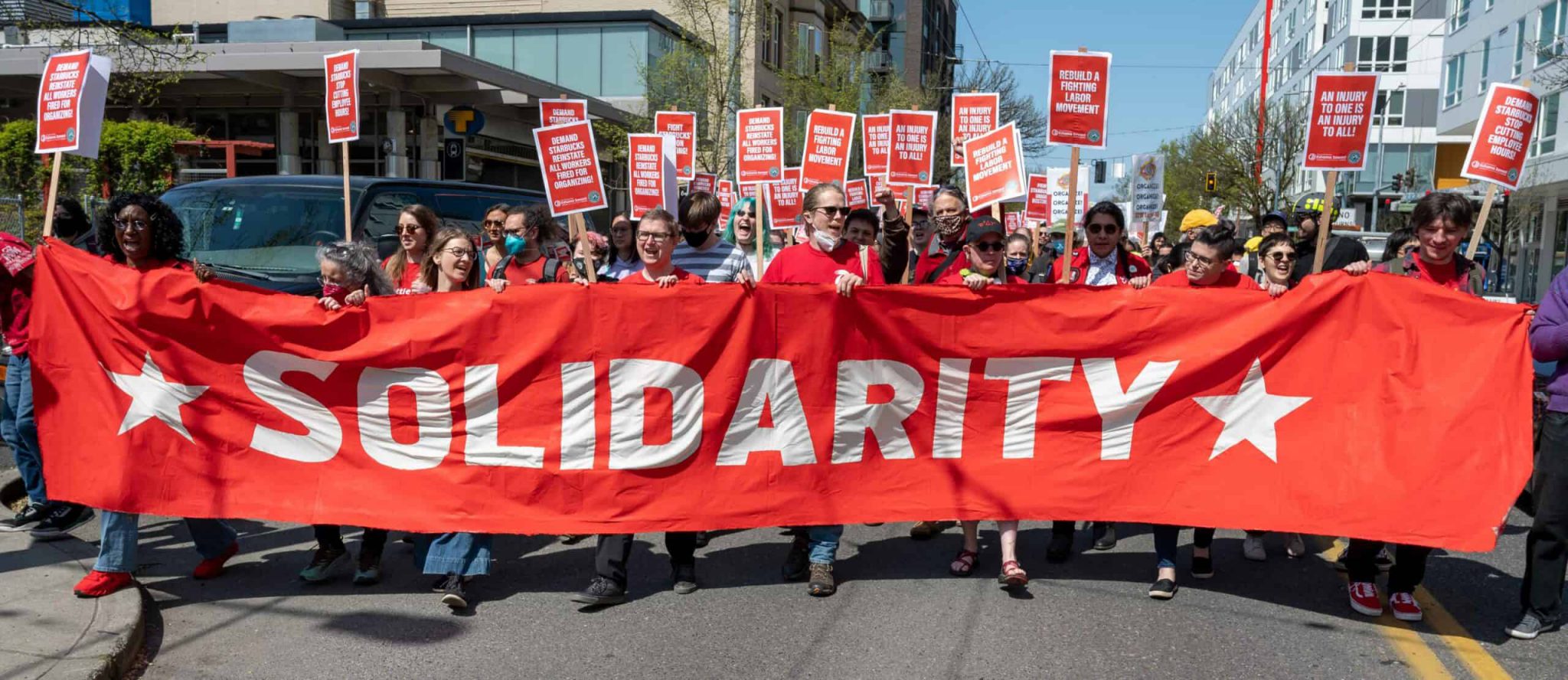
Kevin Vazquez is a staff attorney at the International Brotherhood of Teamsters. He graduated from Harvard Law School in 2023. The opinions he expresses on this blog are his own and should not be attributed to the IBT.
Happy Labor Day Weekend!
This weekend, millions of Americans will fire up the grill or head to the beach to celebrate Labor Day, though few seem to remember the origins—or purpose—of the federal holiday, which is designated to honor the achievements of organized labor in the United States.
In 1894, President Grover Cleveland signed a bill recognizing the first Monday in September as Labor Day and making it an official federal holiday. Uncoincidentally, this was the same year that the Pullman Strike transpired, a three-month labor action that began in Chicago in May and spread throughout the entire U.S. by July. On May 11, 1984, more than 3,000 Pullman Company factory workers in Chicago—most of whom lived in a Pullman “company town” outside of the city—launched a wildcat strike to protest reductions in wages. The dispute, led in part by Eugene V. Debs, then-leader of the American Railway Union (who was arrested and imprisoned for his role), spiraled into a violent, large-scale strike and massive boycott of Pullman railcars that eventually roiled the entire country. The strike was ultimately defeated when the federal government, through President Cleveland, intervened decisively on behalf of employers. Attorney General Richard Olney obtained an infamous “labor injunction” from the courts, which ordered the strikers to stop interfering with the trains (as they were delivering the mail). When they refused to do so, President Cleveland dispatched the military, which promptly killed 30 strikers and labor leaders and injured dozens more, and the strike collapsed. Six days later, seeking to conciliate organized labor, President Cleveland decided to designate Labor Day as a federal holiday honoring the American labor movement—though he opted not to designate May Day, which is celebrated throughout the world but was seen as more “radical” by the federal government.
Returning to the present day, the Department of Labor capped off the month of August by reporting on Friday that the U.S. labor market added 315,000 jobs, in addition to the 526,000 added in July, suggesting that the tight labor market—with all its attendant benefits for workers, who have seen their relative bargaining power vis a vis their employers increase—may begin to slacken, though barring a recession (or Federal Reserve intervention), this process may take years. Indeed, despite the moderate job growth and increased workplace participation rate (the highest since March 2020), the demand for labor remains high, and the Fed continues to weigh further “intervention” to curb inflationary pressures—meaning, of course, deliberately triggering a recession in order to increase unemployment and thus whip inflation. The conventional view among economists is that unemployment and inflation have an inverse relationship, meaning that if inflation is high, it is because unemployment is too low. This view arises from a seductive syllogism: when unemployment is too low, employers must compete for scarce workers; this drives up wages for workers, which forces businesses to raise prices, and rising consumer prices lead to workers demanding even higher wages, thus creating an inflationary spiral. To that end, the Fed has a demonstrated history of choosing to prioritize low inflation—or “price stability”—over full employment, even when the consequence of doing so is triggering a recession that destroys millions of jobs and billions in household wealth. For that reason, the United States has not come close to full employment in more than 20 years.
Indeed, for the majority of the past four decades, the federal government—through the actions of the Federal Reserve—has actively endeavored to keep millions of American structurally unemployed, though this, of course, is rarely admitted forthrightly by policymakers in either party. (But the mask has occasionally slipped, such as when Paul Volcker, Chair of the Federal Reserve from 1979 to 1987 and the architect of the Volcker Shock, told Congress bluntly in 1979 that, for inflation to be reduced, “the standard of living of the average American has to decline.”) In reality, the Fed’s prioritizing price stability over full employment is a component of class warfare: the wealthy are harmed by inflation, which decreases the value of their assets and investments, more than by high unemployment; and, inversely, the working class is harmed by high unemployment, which undermines their bargaining power as a class in the labor market and limits their opportunities for upward mobility, more than high prices for consumer goods. Although COVID threw a wrench into this macroeconomic orthodoxy—and President Biden has offered indications that he is willing to deviate from traditional U.S. fiscal policy—the Fed is again evaluating whether to raise interest rates to “cool off” the economy (i.e., loosen the labor market). Last week, Fed Chair Jerome Powell announced the Fed will raise borrowing costs to decrease growth and “soften” the labor market, thus reducing inflation, but he indicated that the size of the rate hike would depend on the “totality” of the data. “Restoring price stability will likely require maintaining a restrictive policy stance for some time,” Powell said, coded language that means the Fed is once again choosing to fight inflation by fighting workers, even if the aspirational “soft landing” fails to materialize and the result is a full-blown recession.
In other weekend news, Amazon’s efforts to overturn the Amazon Labor Union’s historic win in Staten Island have failed, as an NLRB hearing officer rejected Amazon’s objections to the election on Friday. Immediately after the vote in April, Amazon filed more than two dozen objections with the Board, claiming that the election was tainted not only by the actions of ALU organizers but also by NLRB Region 29 in Brooklyn, which oversaw the election. The marathon hearing, which was open to the public (despite Amazon’s efforts to the contrary), lasted for 24 days, during which both sides submitted documentary evidence and took witness testimony—and the ALU and Amazon’s attorneys often clashed. The legal battle, however, is not yet over: Amazon has announced that it intends to appeal the decision, first to the Board, which, with a Democratic majority, will likely be sympathetic to the union. Then, if necessary, the company can (and almost certainly will) appeal the decision to a federal court of appeals and, ultimately, the Supreme Court—which may be less sympathetic to the workers. In any event, the hearing officer’s ruling is a major victory for the ALU and union organizers.
Finally, Barbara Ehrenreich, the author of “Nickel and Dimed” and “Bait and Switch,” two classic books that exposed the illusions of American society and documented the grim reality of working-class life to millions, died on Thursday at the age of 81. Her books were beautiful—through tragic—testaments to the working class in America: “They neglect their own children so that the children of others will be cared for; they live in substandard housing so that other homes will be shiny and perfect; they endure privation so that inflation will be low and stock prices high,” she wrote in Nickel and Dimed in 2002. “To be a member of the working poor is to be an anonymous donor, a nameless benefactor, to everyone.” She was a prolific writer who also wrote for The New York Times, The Nation, Vogue, and several other publications, and she was also a major figure in the Democratic Socialists of America in the late-twentieth century and founded the Economic Hardship Reporting Project, which seeks to support independent journalism about inequality and the poor, in 2012. No matter the form or the medium through which it was expressed, her work was always centered around justice for the working class and poor. “She was never much for thoughts and prayers,” her son, Ben Ehrenreich, said when announcing her death on Friday. “[B]ut you can honor her memory by loving one another, and by fighting like hell.”
Rest in power, Barbara!






Daily News & Commentary
Start your day with our roundup of the latest labor developments. See all
July 9
In Today’s News and Commentary, the Supreme Court green-lights mass firings of federal workers, the Agricultural Secretary suggests Medicaid recipients can replace deported farm workers, and DHS ends Temporary Protected Status for Hondurans and Nicaraguans. In an 8-1 emergency docket decision released yesterday afternoon, the Supreme Court lifted an injunction by U.S. District Judge Susan […]
July 8
In today’s news and commentary, Apple wins at the Fifth Circuit against the NLRB, Florida enacts a noncompete-friendly law, and complications with the No Tax on Tips in the Big Beautiful Bill. Apple won an appeal overturning a National Labor Relations Board (NLRB) decision that the company violated labor law by coercively questioning an employee […]
July 7
LA economy deals with fallout from ICE raids; a new appeal challenges the NCAA antitrust settlement; and the EPA places dissenting employees on leave.
July 6
Municipal workers in Philadelphia continue to strike; Zohran Mamdani collects union endorsements; UFCW grocery workers in California and Colorado reach tentative agreements.
July 4
The DOL scraps a Biden-era proposed rule to end subminimum wages for disabled workers; millions will lose access to Medicaid and SNAP due to new proof of work requirements; and states step up in the noncompete policy space.
July 3
California compromises with unions on housing; 11th Circuit rules against transgender teacher; Harvard removes hundreds from grad student union.